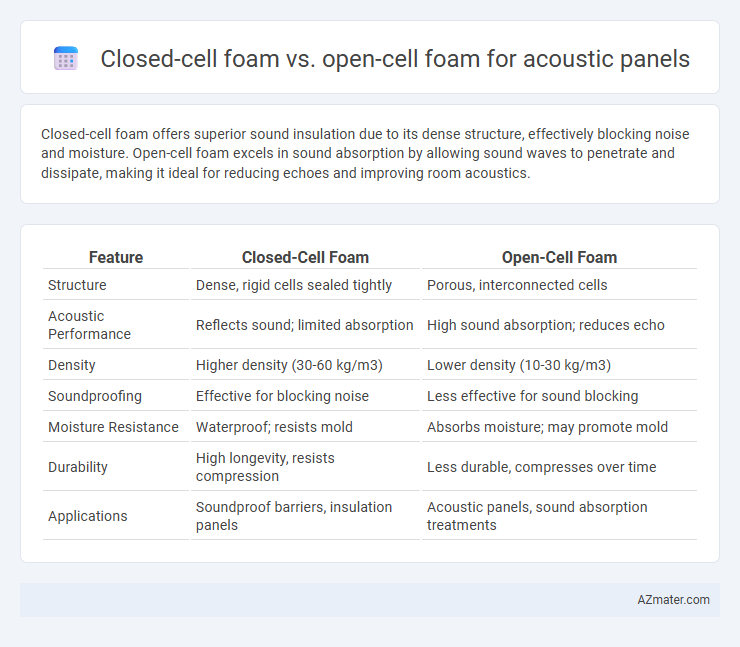Closed-cell foam offers superior sound insulation due to its dense structure, effectively blocking noise and moisture. Open-cell foam excels in sound absorption by allowing sound waves to penetrate and dissipate, making it ideal for reducing echoes and improving room acoustics.
Table of Comparison
| Feature | Closed-Cell Foam | Open-Cell Foam |
|---|---|---|
| Structure | Dense, rigid cells sealed tightly | Porous, interconnected cells |
| Acoustic Performance | Reflects sound; limited absorption | High sound absorption; reduces echo |
| Density | Higher density (30-60 kg/m3) | Lower density (10-30 kg/m3) |
| Soundproofing | Effective for blocking noise | Less effective for sound blocking |
| Moisture Resistance | Waterproof; resists mold | Absorbs moisture; may promote mold |
| Durability | High longevity, resists compression | Less durable, compresses over time |
| Applications | Soundproof barriers, insulation panels | Acoustic panels, sound absorption treatments |
Introduction to Acoustic Foam Panels
Closed-cell foam offers superior sound isolation due to its high density and impermeable structure, effectively blocking noise transmission. Open-cell foam provides enhanced sound absorption by allowing air and sound waves to penetrate its porous surface, reducing echo and reverberation. Acoustic foam panels use these properties to optimize soundproofing and acoustic treatment in studios, theaters, and recording environments.
What is Closed-Cell Foam?
Closed-cell foam is a dense, rigid material characterized by tightly packed cells that prevent air and moisture penetration, making it highly effective for soundproofing in acoustic panels. Its structure provides superior sound absorption and insulation compared to open-cell foam, which has interconnected pores that allow air flow but less sound isolation. Closed-cell foam's durability and resistance to water also enhance acoustic panel longevity in high-humidity environments.
What is Open-Cell Foam?
Open-cell foam is a porous, flexible material characterized by interconnected air pockets that allow sound waves to enter and dissipate effectively, making it ideal for acoustic panels focused on sound absorption. Its lower density compared to closed-cell foam provides greater breathability and better performance in reducing echo and reverberation within rooms. Commonly used in studios and home theaters, open-cell foam enhances sound quality by trapping mid-to-high frequency noises efficiently.
Material Composition and Structure Differences
Closed-cell foam consists of densely packed cells with walls completely sealed, creating a rigid and moisture-resistant structure ideal for acoustic panels requiring sound insulation and durability. Open-cell foam features interconnected, porous cells that allow air to flow freely, enhancing sound absorption and reducing echo through its soft, flexible composition. The material composition directly influences acoustic performance, with closed-cell foam providing higher sound blocking and open-cell foam excelling in sound dampening and diffusion.
Acoustic Performance Comparison
Closed-cell foam provides superior sound isolation due to its dense structure, effectively blocking airborne noise and minimizing sound transmission. Open-cell foam excels in sound absorption by trapping sound waves within its porous structure, reducing echo and reverberation in a room. For acoustic panels, open-cell foam is ideal for absorbing mid-to-high frequencies, while closed-cell foam better suits applications requiring noise blocking and insulation.
Sound Absorption Capabilities
Closed-cell foam offers superior sound absorption at higher frequencies due to its dense structure that reflects and traps sound waves more effectively, making it ideal for reducing echo and controlling noise in smaller spaces. Open-cell foam excels in absorbing low to mid-frequency sounds because its porous, breathable composition allows sound waves to penetrate and dissipate, enhancing overall acoustic performance in larger rooms. Selecting the appropriate foam depends on the specific sound absorption requirements and frequency range targeted in acoustic panel applications.
Durability and Longevity
Closed-cell foam offers superior durability and longevity for acoustic panels due to its dense structure and resistance to moisture, mold, and physical damage. Open-cell foam, while more effective at sound absorption, is less durable because its porous nature allows moisture penetration, leading to faster degradation and reduced lifespan. For long-term acoustic performance, closed-cell foam provides a more resilient and stable solution in demanding environments.
Installation Considerations
Closed-cell foam offers higher density and rigidity, providing superior sound insulation but requires precise cutting and secure fastening due to its firmness, which can complicate installation. Open-cell foam, characterized by its softer, more flexible texture, is easier to cut and fit into irregular spaces, speeding up the installation process but generally demands additional support to maintain its shape and position. The choice depends on the specific acoustic needs, structural compatibility, and ease of handling during installation.
Cost Comparison: Closed-Cell vs Open-Cell
Closed-cell foam for acoustic panels generally costs more per square foot than open-cell foam due to its higher density and superior soundproofing capabilities. Open-cell foam offers a more budget-friendly option, providing effective sound absorption but with less durability and insulation performance. Choosing between the two depends on balancing budget constraints with the desired acoustic treatment effectiveness for the space.
Choosing the Right Foam for Your Space
Closed-cell foam offers superior sound insulation due to its dense structure, effectively blocking noise transmission and ideal for environments requiring maximum noise reduction. Open-cell foam, with its porous and flexible composition, excels in absorbing mid to high-frequency sounds, making it suitable for improving room acoustics and reducing echo. Selecting the right foam depends on the specific acoustic needs of your space, balancing sound absorption and insulation requirements to achieve optimal performance.

Infographic: Closed-cell foam vs Open-cell foam for Acoustic panel
 azmater.com
azmater.com